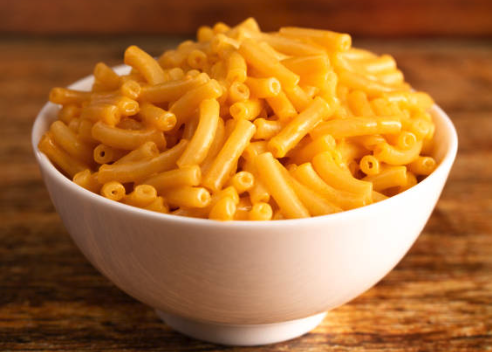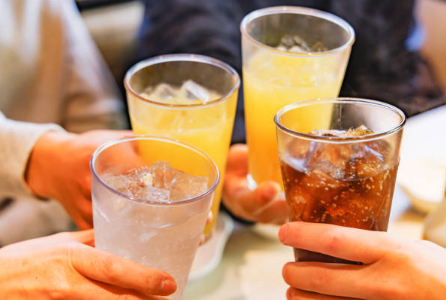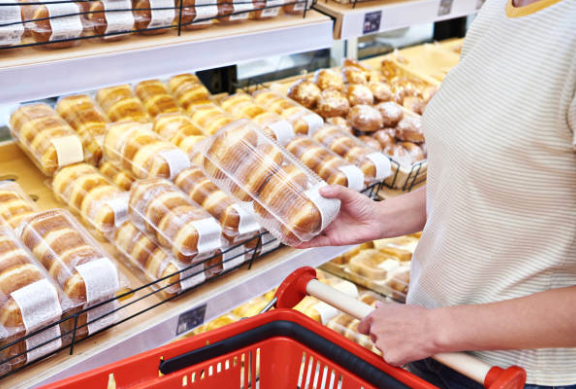
People with dietary restriction who travel abroad often worry about the food they will be served and if it will affect their health. Oddly enough, their trip turns out beautifully and without incident on the eating side. Some believe it may have to do with certain food additives that are banned in Europe but allowed in other countries, like the U.S.A.

- Titanium Dioxide: this is used in bread, flour, candy, canned soup, salad dressing, macaroni and cheese (in a box) and prepackaged baked goods to give food a white appearance. It was deemed unacceptable for food products by the European Food Safety Authority (EFSA) in May 2021. This was due to concerns of genotoxicity (the properties of a chemical that can impair DNA or chromosomes.) It is considered “a possible carcinogenic to humans” according to the International Agency for Research on Cancer. They made the point that even if the absorption of titanium doxide particles is low, they accumulate in the body and can affect our DNA.
The FDA however said that available studies “do not demonstrate safety concerns connected to the use of titanium dioxide as a color additive.”
- Butylated Hydroxyanisole (BHA) and Butylated Hydroxytoluene (BHT): this is used in crackers, chips, premade baked goods, granola bars and chips. Its purpose is to prevent oils from oxidation. Both preservatives are considered to be a human carcinogen by the National Toxicology Program and are restricted in Europe.

- Synthetic Food Coloring: Used in just about anything we can imagine from candy, sodas, sports drinks, cake and cupcake frosting, salad dressings and chips. They are used to create a better appearance. Petroleum-based food dyes like Yellow No.5, No. 6 and Red No. 40 are thought to create behavioral challenges and hyperactivity as indicated in this recent review. In 2021, despite a report issued by the California Environmental Protection Agency that current federal guidelines on synthetic food dyes were outdated, the report did not acknowledge literature showing the negative effect of such dyes on kids and adults. The EU requires a warning label if the food contains added colors.
- Brominated Vegetable Oil (BVO): This is used in sodas and sports drinks as an emulsifier. Although some U.S. companies have discontinued use, many still use this as it has not been banned by the FDA. Note that the FDA announced a proposal to revoke authorization for the use of BVO as a food additive on Nov 2, 2023. It is banned in the EU as a food additive because it has been associated with neurological disease in adults and reproductive problems in animals.
- Azodicarbonamide (ADA): Used in bread and baked goods as a bleaching agent but most commonly used in making various kinds of plastic. Animal research has shown that ADA could be an organ and cellular toxin and it can cause respiratory complication in humans. It is prohibited for use as a food additive in the EU.

- Potassium Bromate: Again, used in flour, bread and baked goods to enhance the texture of flour-based foods. Small amounts of bromate found in potassium bromate are shown to be carcinogenic in animal studies. When it was labeled “possibly carcinogenic” by the International Agency for Research on Cancer it was banned in European countries. It was also banned in October 2023 in California although the law does not go into effect until 2027.
- Recombinant Bovine Growth Hormone (rBGH): Used in conventional dairy prodcuts it is a hormone that stimulates greater milk production in cows. The EU banned this hormone in 1999. Although some research has found a potential relationship between increased blood levels of growth hormone because of rBGH use and hormone-related cancers such as breast and testicular. According to the American Cancer Society the link between rBGH and cancer is “inconclusive” and warrants further investigation. Note that if you buy organic dairy products you are safe as the USDA forbids its use in certified organic products.
“Food additives in the United States are subject to review and approval by the FDA unless the substance is generally recognized as safe (GRAS) by experts.” Manufacturers can use their discretion in determining the use of a GRAS substance and don’t have to secure FDA approval. In the EU there is no “GRAS LOOPHOLE” and a food additive must be assessed by the EFSA and authorized by the European Commission before it is used. Note that many additives have not been reviewed by the FDA for decades, despite the fact that it has the authority to do so, while all food additives approved for use in EU before Jan 20, 2009 were required to undergo reassessment by the EFSA.
Source:
7 Food Additives Banned in Europe, Commonly Used in the US by Vance Voetberg, updated 11/9/2023, www.theepochtimes.com
食事制限のあるアメリカ人が外国に旅行することになると、現地で出される食べ物とその健康への影響を心配しがちです。ところが驚いたことに、食事に関してはまったく問題がなかったという結果になります。その理由として、ヨーロッパで禁止された食品添加物のなかに米国や他の国では今も許可されているものがあることを挙げる人がいます。
- 二酸化チタンは白色の着色料、つまり見た目を白くするための食品添加物で、パン、小麦粉、キャンディ、缶詰スープ、サラダドレッシング、マカロニチーズ(箱入り)、出来合いの焼菓子などに使われています。ヨーロッパでは2021年5月に欧州食品安全機関(EFSA)が食品添加物としての使用を禁止しました。遺伝毒性と言って、DNAや染色体に変化を引き起こす変異原となる懸念があるためです。また、国際がん研究機関(IARC)では、二酸化チタンを「人に対する発がん性物質の可能性がある」と見なしています。二酸化チタン粒子の吸収率は低いものの、体内に蓄積してDNAに影響する可能性がある点を、IARCは指摘しています。
しかし、米国の食品医薬品局(FDA)は、現時点で入手できる研究からは、「着色料としての二酸化チタンの使用に伴う安全性の懸念は実証されていない」としています。
- ブチルヒドロキシアニソール(BHA)とジブチルヒドロキシトルエン(BHT):クラッカー、チップス、出来合いの焼菓子、グラノラバーなどに使われており、その目的は油脂の酸化を防止することです。どちらも、米国の国家毒性プログラムで人に対する発がん性物質と見なされており、ヨーロッパでは制限されています。
- 合成着色料:キャンディ、炭酸飲料、スポーツドリンク、ケーキやカップケーキのデコレーション、サラダドレッシング、チップスなど、思い付くかぎりほぼすべての食べ物に使われています。見た目を良くするためです。黄色5号、黄色6号、赤色40号をはじめ石油化学系の着色料は行動変化や落ち着きのなさを引き起こすことが、こちらの最近の研究で指摘されました。2021年にはカリフォルニア州の環境保護局が、合成着色料に関する連邦政府の現行のガイドラインは時代遅れだとする報告書を発行しましたが、その報告書でも、子供と大人に合成着色料が及ぼす悪影響を示した文献には言及しませんでした。EUでは、着色料を使用した食品に警告ラベルの表示を義務付けています。
- 臭素化植物油(BVO):これは乳化剤として炭酸飲料やスポーツドリンクに使われています。米国の一部の企業はすでに使用をやめていますが、FDAが禁止したわけではないため、今も多くの企業が使用しています。FDAは2023年11月2日、食品添加物としてのBVOの使用の許可取消を提案しました。EUでは、食品添加物としての使用はすでに禁止されています。大人の神経疾患への影響と動物の生殖機能への影響が指摘されているためです。
- アゾジカルボンアミド(ADA):漂白剤としてパンや焼菓子に使われていますが、最も一般的な用途は各種プラスチックの製造工程です。動物試験ではADAに器官毒性と細胞毒性がある可能性が示されており、人間では呼吸器系の問題を引き起こす可能性があります。EUでは、食品添加物としての使用が禁止されています。
- 臭素酸カリウム:これも小麦粉、パン、焼菓子に使われる添加物で、小麦粉を原料とする食品の触感を高めるものです。臭素酸カリウムに含まれる少量の臭素酸塩が、動物試験で発がん性物質であると確認されています。IARCの「発がん性物質の可能性」というラベルが付けられた時点で、ヨーロッパでは禁止されました。また、カリフォルニア州では2023年10月に禁止法案が成立しましたが、施行は2027年の予定です。
- 遺伝子組み換え牛成長ホルモン(rBGH):非オーガニックの乳製品に使われており、乳牛の乳量を増加させるためのホルモンです。EUでは1999年にこのホルモンの使用を禁止しました。rBGHの使用によって血中の成長ホルモン値が高まることで、乳がんや精巣がんなどホルモンに関係したがんにつながる可能性が一部の研究で指摘されましたが、米国のがん学会では、rBGHとがんの関連性は「決定的でない」ため、さらなる研究が必要としています。米国農務省(USDA)のオーガニック認証ではrBGHの使用を認めていないため、USDAオーガニック認証マークのある乳製品を購入すれば安全です。
「米国の食品添加物は、専門家によって一般に安全と認められる(GRAS:generally recognized as safe)物質と指定されたのでないかぎり、FDAの審査・承認を受ける必要がある」と、The Epoch Timesの記事は指摘しています。食品メーカーは、GRAS物質の使用に関してはFDAの承認を受けずに自社の裁量で決めることができます。EUではGRAS物質のような「法の抜け穴」が存在せず、食品添加物を使用する前にEFSAの評価を受けて欧州委員会から承認を得る必要があります。FDAには見直しの権限があるにもかかわらず、過去何十年にもわたってFDAが見直しをしていない食品添加物が多数あることに注意してください。一方、EUでは、2009年1月20日以前に承認された食品添加物はすべて、EFSAによる再評価を受けることが義務付けられました。
出典:
7 Food Additives Banned in Europe, Commonly Used in the US(ヨーロッパで禁止され、米国では一般的に使われている7つの食品添加物)、著:Vance Voetberg、2023年11月9日更新、www.theepochtimes.com
